Alaska and Minnesota
Description
In order to foster a data-driven process, many states utilize benefit-cost ratios (BCR) or similar formula methods to prioritize potential projects for Highway Safety Improvement Program (HSIP) funding. These formulas often rely on estimates of crash reduction from the implementation of specific countermeasures. These estimates, in turn, rely heavily on the use of crash modification factors (CMFs). There are a number of resources for estimating CMFs, including the Federal Highway Administration's CMF Clearinghouse. However, the number of potential countermeasures far exceeds the number of available CMF studies. Many viable countermeasures don't have an approved CMF, and as a result, states are often reluctant or unwilling to include these projects in their prioritization process.
To establish the merit of countermeasures lacking a CMF, several states have developed processes for justifying projects using alternative means. The Alaska Department of Transportation and Public Facilities (AKDOT&PF) uses a sensitivity analysis as documented in the Alaska HSIP Handbook to include projects that would otherwise go un-ranked in their prioritization process due to their lack of an approved CMF; Figure 1 highlights methods in which AKDOT analyzes and selects projects Two BCRs are calculated assuming CMFs of 5% and 100% for crashes potentially corrected by the proposed countermeasure(s). The two resulting ratios, along with a narrative explaining the project benefits, are then used to justify project advancement. Systemic improvement projects that prevent or reduce the severity of crashes can also advance using this method, as these types of projects may not have sufficient crash data to generate BCRs meeting the threshold for projects ranked in the typical manner.

Figure 1. Alternative Project Prioritization Methodologies (Source: Adapted from the Alaska HSIP Handbook)
The Minnesota Department of Transportation's (Mn/DOT's) Metro District Traffic Engineering Unit, which is responsible for the selection of projects for HSIP Funding in the Twin Cities region, employs a similar strategy. Instead of relying on crash modification factors, project proposals may contain an estimate of crash reductions based on logical assumptions. Each proposal must thoroughly and logically demonstrate how each improvement will impact each type of crash. Before any project proposal is submitted, Mn/DOT encourages project initiators to contact a member of the HSIP Committee to discuss crash reduction assumptions for each improvement. The HSIP Committee then reviews the proposal for accuracy and logic.
Key Accomplishments
- Developed a documented methodology for considering HSIP projects with safety countermeasures that do not include crash modification factors
Results
Both AKDOT&PF and Mn/DOT established documented means (via their HSIP Guides) for the consideration of alternative countermeasures in their HSIP project selection process. By developing procedures for evaluating projects with countermeasures that do not have CMFs, they employed a more encompassing arsenal of countermeasures to improve safety performance through the most effective means possible.
Contacts
Jeff Jeffers, P.E.
State Traffic & Safety Engineer
Alaska Department of Transportation & Public Facilities
6860 Glacier Highway
Juneau, AK 99801
(907) 465-8962
Jeff.Jeffers@alaska.gov
Julie Whitcher, P.E., PTOE
Assistant State Traffic Safety Engineer
Minnesota Department of Transportation
395 John Ireland Blvd
St. Paul, MN 55155
(651) 296-3000
Julie.Whitcher@dot.state.mn.us
